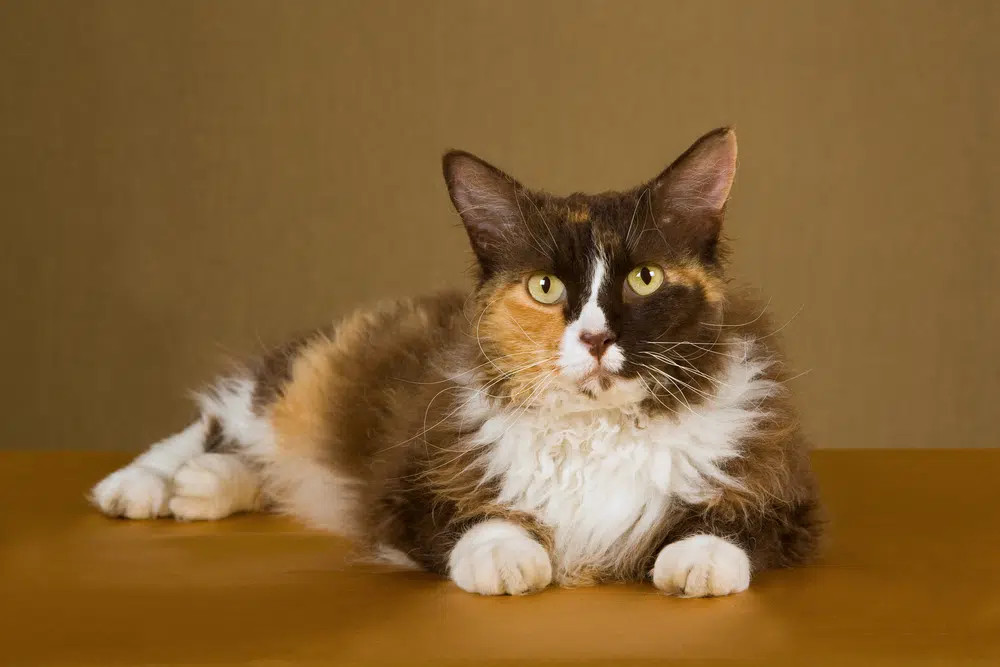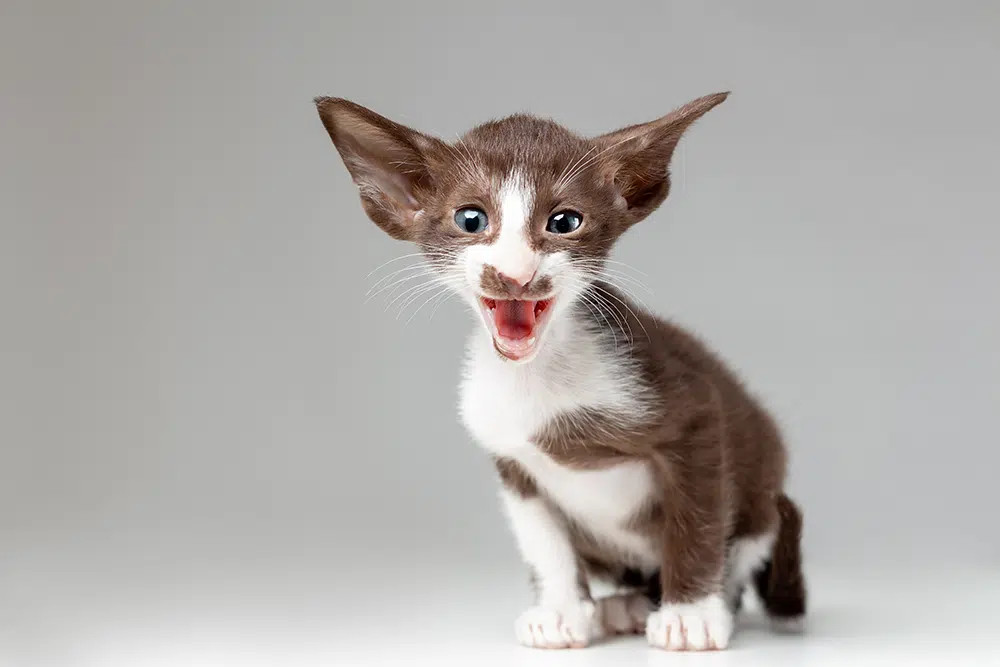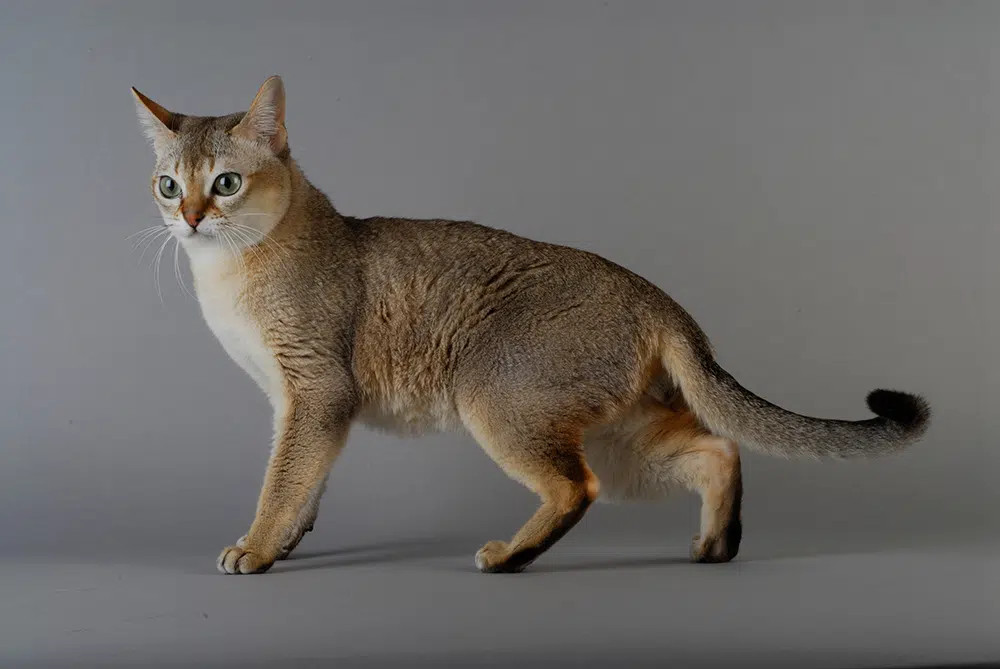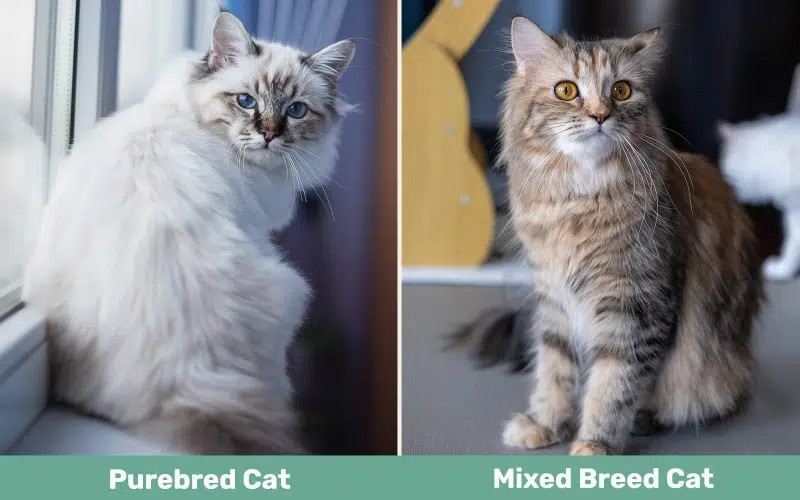Are you curious about your feline friend’s ancestry? What Is My Cat Breed Quiz? This is your comprehensive guide from solcat.net to unveil your cat’s lineage, even without genetic testing. Discover how to identify your cat’s breed by focusing on key physical traits and behaviors. By observing size, face shape, coat type, and personality, you can narrow down the possibilities and gain a better understanding of your beloved pet.
Want to unlock the secrets of your cat’s origins? At solcat.net, explore a treasure trove of articles, images, and videos to deepen your understanding and appreciation for all things feline. Uncover your cat’s unique story today with our comprehensive breed identification tips. Dive into the world of cat breeds and find out what makes your furry companion so special.
1. How Can I Determine My Cat’s Breed?
Determining your cat’s breed involves carefully observing their physical characteristics and behaviors. To determine your cat’s breed, pay attention to their unique traits and temperament using the guidelines below. By noting these qualities, you can create a search query to uncover the breed of your beloved cat. You can also find details about your cat’s lineage and better understand their origins.
1.1 Size and Weight: What Does My Cat’s Size Tell Me?
The size and weight of your cat can be a significant clue to their breed. Cats come in a variety of sizes, from tiny dwarf cats weighing around 4 pounds to giant breeds like the Maine Coon, which can exceed 25 pounds. Each breed is generally classified by its size, making this a useful starting point.
1.2 Large Cats: How Big Is Considered Large?
Cats that weigh over 15 pounds are generally classified as large cats. While some can weigh more, others might be as light as 12 pounds, which can cause confusion with medium-sized cats. Some rare specimens can even weigh over 30 pounds. These cats are not just heavy; they are also tall and long. Large cats often stand over 8 inches tall and can reach heights of 16 inches. Their length can range from 30 inches to a record-holding 47.2 inches.
1.3 Medium-Sized Cats: What Are the Average Dimensions?
Most cat breeds fall into the medium-sized category. This is a broad group, so size alone may not be enough for definitive identification, but it remains a contributing factor. Medium-sized cats typically weigh between 9 and 12 pounds. If your cat is heavier, it’s likely a large cat, and if it’s lighter, it’s likely a dwarf cat.
 Siamese cat sitting on the floor indoor
Siamese cat sitting on the floor indoor
1.4 Small or Dwarf Cats: How Can I Identify a Small Breed?
If your cat is fully grown but weighs less than 9 pounds, you likely have a small or dwarf cat. These cats are relatively easy to identify, and there aren’t many dwarf breeds. Munchkins are the most well-known, and many other dwarf breeds share Munchkin genetics.
2. What Can My Cat’s Face Shape Tell Me About Its Breed?
The shape of your cat’s face can be a crucial clue to their breed. While not all cats have distinctive face shapes, those with round, flat faces or narrow, triangular faces can be easier to categorize.
2.1 Round and Flat-Faced Cats: What Are Brachycephalic Breeds?
Certain cat breeds, known as brachycephalic breeds, have flat faces that appear as if they were pushed in. These breeds have shorter skulls than others. While this trait is desirable in some breeds, such as Persians, it’s important to note that brachycephalic breeds can be susceptible to various health issues due to their unique anatomical structure, as noted by VCA Hospitals.
2.2 Narrow-Faced Cats: Which Breeds Have Triangular Faces?
In contrast to flat-faced cats, narrow-faced felines have triangular faces. There are even fewer narrow-faced cats than flat-faced ones, making them relatively easy to identify.
3. How Do Ear Shapes Help Identify Cat Breeds?
The shape of your cat’s ears can be a significant indicator of their genetic makeup. Certain traits, such as folded or curled ears, are unique to a few breeds, making them easier to identify. These ear shapes are often caused by genetic mutations and have become defining characteristics of specific breeds.
3.1 Curled Ears: What Breeds Have Arched Ears?
Curled ears are shaped like an arch, curling backward and sticking up high, resembling small horns. These distinctive ears are a hallmark of certain breeds.
3.2 Folded Ears: What Are the Health Considerations?
Cats with folded ears are often grouped with curled-ear cats, but there is a significant difference. Curled-ear cats are generally healthy, whereas folded ears result from a genetic mutation that can cause health issues, including deformities and arthritis, as noted by Catster. The gene that causes their ears to fold affects cartilage throughout their bodies.
3.3 Tufted Ears, Lynx Tips, or Ear Furnishings: What Are These Ear Adornments?
Ear tufts, also known as lynx tips, are tufts of fur that grow from the tips of a cat’s ears. They help keep debris out while directing sound in. Ear furnishings are similar hairs that grow inside a cat’s ears. These ear adornments can help narrow down your cat’s breed.
4. Can Eye Color Help Determine My Cat’s Breed?
Eye color can provide additional clues when identifying your cat’s breed. Cats display a wide range of eye colors, and certain breeds are known for specific hues.
4.1 Uncommon Eye Colors: What Is Heterochromia?
Some cats have eyes of different colors, a condition known as heterochromia. This genetic anomaly is linked to the white dominant and white spotting genes, and certain breeds are more likely to exhibit it.
5. What Does My Cat’s Coat Type Indicate About Its Breed?
Your cat’s coat can offer another clue as to its breed. Cats can have long, short, curly, or no hair. Many breeds are known for specific coat types, making this a valuable factor in identification.
5.1 Longhaired Cats: Which Breeds Have Fluffy Coats?
Longhaired cats have long, fluffy coats that can make them appear larger. These breeds have thick fur and tend to shed quite a bit.
5.2 Shorthaired Cats: What Are the Common Breeds?
Shorthaired cats have short fur that lies close to their bodies. They require less grooming than longhaired cats, and their coats are easier to maintain.
5.3 Curly-Haired Cats: How Do I Care for a Curly Coat?
Curly-haired cats have curly coats that require more maintenance than straight coats due to tangling. These cats can have long or short curly hair.
 LaPerm tri-colored cat
LaPerm tri-colored cat
5.4 Hairless Cats: Why Are They Popular?
Hairless cats have a unique look and are easy to identify due to their lack of fur. They are popular among people with cat allergies.
6. How Do Coat Colors, Patterns, and Markings Help Identify My Cat’s Breed?
While your cat’s color won’t immediately reveal their breed, certain colors, patterns, and markings are specific to some breeds, adding another clue to the identification process.
6.1 Solid Color: What Breeds Are Typically One Color?
Cats with a single color are considered solid-colored. They can come in various colors, including black, white, brown, and red.
6.2 Bi-Color: What Is a Piebald Cat?
Bi-colored cats have two colors on their bodies. Also known as piebald, these cats have one main color, with white as the second color. The white can cover most of the coat or appear as small patches.
 Blue tabby maine coon cat running fast
Blue tabby maine coon cat running fast
6.3 Tortoiseshell: What Colors Are Common?
Tortoiseshell cats are similar to bi-colored cats but lack white in their coats. Instead, they have a base color with a secondary color appearing as patches. The most common colors are orange and black, though others include blue, chocolate, red, yellow, and cream.
6.4 Calico: What Makes Calico Cats Unique?
Calico cats have tri-colored coats, with white as one of the colors and any other two colors making up the pattern. Almost all calico cats are female, with only one in 3,000 being male, and most of these males are sterile.
6.5 Points: What Does Color-Pointed Mean?
Color-pointed cats have dark coloration on their face, feet, ears, and tail, contrasting with the lighter color on the rest of their coat. The points and base coat can come in various colors.
7. How Does Tail Length Factor Into Breed Identification?
Variations in tail length can be a telling trait for identifying your cat’s breed. While most cats have standard tails, short tails can be a significant clue.
7.1 Short Tails: Which Breeds Have Naturally Short Tails?
Short tails can help determine your cat’s breed, as only a few breeds exhibit this trait. Many of these breeds are named after this unique feature.
8. How Does Behavior Indicate My Cat’s Breed?
While each cat has a unique personality, certain behavioral traits and temperaments are typical of specific breeds. These traits can help point to a particular breed in your cat’s lineage.
8.1 Smart Cat Breeds: Which Cats Are Known for Intelligence?
Cats are generally considered intelligent, but some breeds are notably smarter than others.
8.2 Noisy Cat Breeds: Which Cats Are More Vocal?
Many cats are quiet, but some are extremely vocal and love to purr, sing, or chat with their owners. Vocalness is a trait common to a few breeds.
 Bicolor oriental cat kitten
Bicolor oriental cat kitten
8.3 Calm and Docile Cat Breeds: Which Cats Are More Reserved?
Many cats are active and energetic, but some are quiet, reserved, and docile, making them easier to identify.
8.4 Friendly Cat Breeds: Which Cats Are More Sociable?
While cats have a reputation for being standoffish, some are friendly and inviting creatures that enjoy interacting with people.
8.5 Independent Cat Breeds: Which Cats Are More Self-Reliant?
Some cats prefer attention on their own terms and can be quite independent, believing themselves to be in charge.
 Singapura cat on grey background
Singapura cat on grey background
8.6 Cat Breeds That Like Water: Which Cats Enjoy Swimming?
Most cats avoid water, but some breeds are attracted to it.
9. How Can I Use These Traits to Determine My Cat’s Breed?
Determining your cat’s breed can be challenging, but you can follow three methods using the criteria outlined above. List the traits your cat displays and enter them into a search engine.
Example Search: Cat breed + calm + large + short fur + tan + colored points
Alternatively, use the breed lists provided for each trait. If one breed appears consistently across all traits, your cat likely belongs to that breed. The search results might not be definitive but should point you in the right direction. If your cat is a mixed breed, their ancestry may include multiple breeds listed in your search results.
10. Should I Consider Genetic Testing to Determine My Cat’s Breed?
Without genetic testing, you can’t be 100% sure of your cat’s breed, even with careful observation. Genetic testing analyzes your cat’s DNA to accurately determine their genetic makeup.
This is particularly useful for mixed-breed cats, as they can display traits from multiple breeds, making their lineage difficult to pinpoint. Genetic testing can easily overcome this challenge. Your veterinarian can provide more information about genetic testing.
Genetic testing can also reveal potential health concerns, allowing you to take proactive measures.
 Purebred vs Mixed Breed Cat side by side
Purebred vs Mixed Breed Cat side by side
Understanding your cat’s breed can help you better care for their specific needs. Visit solcat.net for more expert advice and resources on cat breeds and care. Discover a wealth of information, from detailed breed profiles to tips on nutrition and health. Join our community of cat lovers and share your experiences and insights.
Frequently Asked Questions (FAQ) About Cat Breeds
1. What is the most common cat breed in the United States?
The most common cat breed in the United States is the Domestic Shorthair, which is not a specific breed but rather a mix of various breeds. These cats are known for their adaptability and diverse appearances.
2. How many recognized cat breeds are there worldwide?
According to The International Cat Association, there are more than 70 officially recognized cat breeds worldwide.
3. Can a cat’s personality be determined by its breed?
While individual cats have unique personalities, certain behavioral traits and temperaments are common among specific breeds. These can provide clues to a cat’s breed but are not definitive.
4. What are some of the friendliest cat breeds?
Some of the friendliest cat breeds include Ragdoll, Maine Coon, and Burmese. These cats are known for their affectionate and sociable nature.
5. Are mixed-breed cats healthier than purebred cats?
Mixed-breed cats often have a wider genetic pool, which can reduce the risk of inherited health conditions. However, both mixed-breed and purebred cats can lead healthy lives with proper care.
6. How can I tell if my cat is a specific breed?
You can identify your cat’s breed by observing their physical characteristics, such as size, face shape, ear shape, coat type, and tail length, as well as their behavioral traits. Genetic testing can provide a more definitive answer.
7. What is heterochromia in cats?
Heterochromia is a condition where a cat has eyes of different colors. This genetic anomaly is linked to specific genes and is more common in certain breeds.
8. Why do some cats have folded ears?
Folded ears in cats are caused by a genetic mutation that affects the cartilage throughout their bodies. This trait is most commonly seen in Scottish Fold cats.
9. What are some cat breeds that are known to enjoy water?
Some cat breeds that enjoy water include the Turkish Van and Maine Coon. These cats have water-resistant coats and a natural affinity for playing in water.
10. Is genetic testing necessary to determine my cat’s breed?
Genetic testing is not always necessary but provides the most accurate way to determine your cat’s breed, especially for mixed-breed cats. It can also reveal potential health concerns.
Visit solcat.net today for more information and resources to help you understand and care for your feline companion. Join our community of cat lovers and share your experiences!
Address: 950 Alaskan Way, Seattle, WA 98104, United States
Phone: +1 (206) 386-4000
Website: solcat.net
